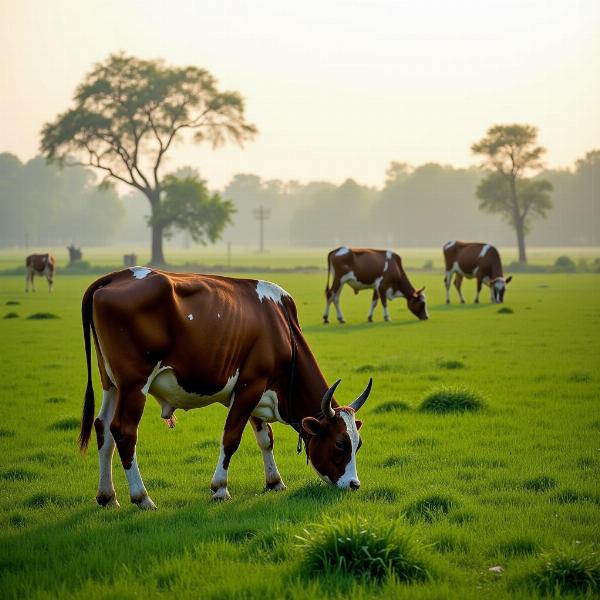Grazing, a common sight in rural India, holds a deeper meaning than simply animals eating grass. Understanding the meaning of grazing in Hindi, along with its cultural and economic significance, offers valuable insights into Indian agriculture and lifestyle. This article explores the various aspects of grazing, from its literal translation to its implications for sustainable land management.
Unpacking “Grazing”: Hindi Translations and Cultural Context
The most common Hindi word for grazing is “चरना” (charna), which translates directly to “to graze.” This verb encapsulates the act of animals feeding on grass in open pastures. Other related terms include “चराई” (charai), which refers to the act or process of grazing, and “चरवाहा” (charwaha), meaning a herder or shepherd. These terms are deeply embedded in the rural lexicon, reflecting the importance of livestock and grazing in Indian agriculture. Think of the vibrant imagery of cows, goats, and sheep dotting the landscape, a quintessential part of rural India. This practice, passed down through generations, forms the backbone of many rural economies.
 Grazing in Rural India
Grazing in Rural India
Beyond the Basics: Exploring Different Types of Grazing
Beyond the simple act of animals eating grass, grazing encompasses various practices, each with its specific term in Hindi. For instance, “घास चरना” (ghaas charna) specifically refers to grazing on grass. This distinction highlights the diverse flora consumed by grazing animals. Understanding these nuances adds depth to our comprehension of the term “grazing” in Hindi.
Overgrazing and its Impact
The concept of overgrazing, a serious environmental concern, is represented by “अतिचराई” (aticarai) in Hindi. This term emphasizes the detrimental effects of excessive grazing on land and vegetation. It highlights the delicate balance required between livestock grazing and environmental sustainability. Overgrazing can lead to soil erosion, desertification, and a decline in biodiversity.
Grazing and the Indian Economy: A Symbiotic Relationship
Grazing plays a crucial role in the Indian economy, particularly in rural areas. It provides sustenance for millions of livestock, contributing to milk, meat, and wool production. This dependence on livestock underscores the significance of grazing. “पशुचारण” (pashucharan), meaning animal grazing, emphasizes the economic importance of this practice.
Grazing and Sustainable Practices
Sustainable grazing practices, aimed at balancing economic benefits with environmental protection, are gaining traction. These practices are crucial for ensuring the long-term health of grazing lands.
Conclusion: The Multifaceted Meaning of Grazing in Hindi
The meaning of grazing in Hindi extends far beyond its literal translation. From “चरना” (charna) to “अतिचराई” (aticarai), each term reveals a different facet of this essential practice. Understanding these nuances provides a deeper appreciation for the cultural, economic, and environmental significance of grazing in India. By promoting sustainable grazing practices, we can ensure the continued prosperity of both the land and the communities that depend on it.
FAQs
- What is the most common Hindi word for grazing? The most common Hindi word for grazing is “चरना” (charna).
- What is the Hindi word for overgrazing? The Hindi word for overgrazing is “अतिचराई” (aticarai).
- How does grazing contribute to the Indian economy? Grazing supports livestock rearing, contributing to milk, meat, and wool production, which are vital for the Indian economy.
- Why is understanding the meaning of grazing in Hindi important? Understanding the meaning of grazing in Hindi offers insights into Indian agriculture, culture, and the importance of sustainable land management.
- What is the meaning of “चरवाहा” (charwaha)? “चरवाहा” (charwaha) means a herder or shepherd.
- What does “चराई” (charai) mean? “चराई” (charai) refers to the act or process of grazing.
- What are some sustainable grazing practices? Rotational grazing and controlled stocking rates are examples of sustainable grazing practices.
About Meaning-Hindi.in
Meaning-Hindi.in is your one-stop solution for all your Hindi translation needs. We offer a wide range of professional translation services, including business and commercial document translation, certified and legal document translation, technical and user manual translation, website and localization services, educational and academic document translation, and specialized industry translation. Our team of expert Hindi linguists ensures accurate and culturally sensitive translations for all your projects. Need a fast and reliable Hindi translation? Contact us today at [email protected] or call us at +91 11-4502-7584. Meaning-Hindi.in is committed to delivering high-quality translations that bridge language barriers and connect cultures.